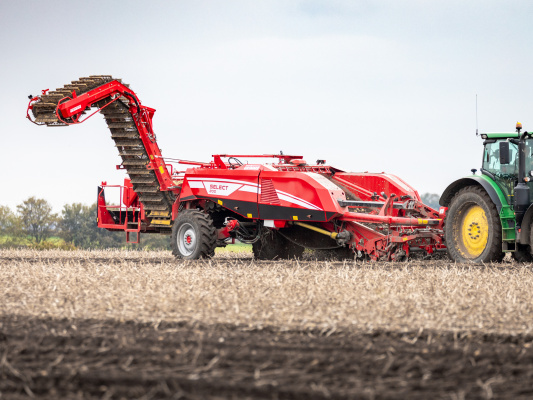
EVO:
THE EVOLUTION OF THE SE SERIES
In 1991 the most successful principle of a potato harvester in decades was launched.
In 1991 the most successful principle of a potato harvester in decades was launched. The single-row harvester SE 70-20 excelled due to a combination of soil-sieving, an inclined conveyor and crop separation. Prior haulm topping, ring elevators and simple sieving conveyors, which were still very common at that time, were no longer necessary. In 1997, a two-row version of this harvester, the so called type SE 150-60 with three separators and later on, in 2012, the type SE 260 with two separators were launched onto the market. Following the expiry of the patent protection, today all well-known competitors are imitating this long lasting successful principle.
The new evolution in harvesting technology: The EVO 290
With the new 2 row trailed harvester EVO 290 the market needs for enhanced harvesting capacity and soil conservation are met, allowing greater levels of performance, using technology from the highly successful SE 260. The new name of the machine suggests that this is an evolution of the well proven - an evolution to meet the modern requirements. 3 wheels as opposed to 2 allows for less soil compaction and a 9 as opposed to a 6 tonne bunker are the two most noticeable features. As well as this there are also many new and improved components within the machine.
More performance with VarioDrive and 20% more sieving area
The optional VarioDrive allows for work in all kind of conditions, due to the advantage of having both a mechanical and hydraulic drive.
Purely mechanical systems have the advantage that they are highly energy efficient, whereas the hydraulics can be adjusted independently of the PTO speed allowing greater operator comfort. In addition, it is easy to avoid blockages through reversing the direction of the main webs, which can save both time and money. The size of the second main web has been increased by 20 % in comparison to the SE 260.
9 t bunker, the biggest in its class
The EVO 290 is the first trailed potato harvester with a bunker capacity of 9 tonnes. The capacity was increased by 50 % in comparison to the SE 260. This results in a noticeably smaller number of so called "multiple overrunning" of wheels when the bunker is full. The 5.5 t NonstopBunker is an optional extra, which due to the backwards moving bunker floor always allows for full utilization of the bunker space which truly allows a nonstop harvesting. This improves performance by up to 20% in comparison with a standard bunker.
TriSys: TriSys: Three Wheels - big advantages
The new tricycle-chassis, called TriSys, on the EVO 290 certainly catches the eye. The soil contact surface can be increased by 65% compared to the SE 260. The calculation of the soil contact surface of the tyres was done with by help of a model from the Swiss Federal Research Institute of agricultural science and engineering (FAT - Agroscope). Steering of all three wheels is standard. All wheels can be driven hydraulically allowing far better traction. As an alternative the following large wheels are available as an option: 750/60-30.5 (l/h-side) and a 1000/50 R25 (r/h-side).
Driver Comfort package
Driver assistance systems increase operating comfort, such as the videosystem Visual Protect which automatically switches to a camera when it detects a potential hazard (e.g. potential blockages in the separator). As a result the operator always has an overview of the machine and can avoid potential hazards. Speedtronic, a load dependant and fully automatic speed control system for the separators and the picking web is available as an option, too. ISOBUS is as standard.
The know how and experience of over 65000 potato harvesters has gone into the new EVO- series.
The EVO 290 is another high performance 2-row bunker harvester alongside the SE 260 and the SE 150-60.
The newly designed EVO 290 will make its public debut at Agritechnica and will be available in time for the 2018 season.
Video EVO 290 prototype
Innovation
Whether its new machines or digital solutions, you'll find all the latest information here.
Display all updates







